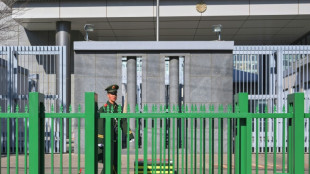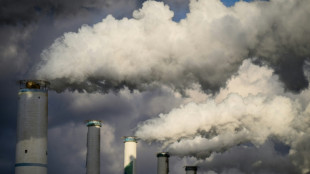
-
 Trump hosts Saudi prince for first time since Khashoggi killing
Trump hosts Saudi prince for first time since Khashoggi killing
-
Tonga's Katoa out of NRL season after brain surgery

-
 Japan warns citizens in China over safety amid Taiwan row
Japan warns citizens in China over safety amid Taiwan row
-
In Somalia, a shaky front line barely holds back the 'dogs of war'

-
 Shares in 'Baby Shark' studio jump on market debut
Shares in 'Baby Shark' studio jump on market debut
-
Thunder breeze past Pelicans, Pistons overpower Pacers

-
 Grieving Cowboys remember Kneeland, defeat Raiders
Grieving Cowboys remember Kneeland, defeat Raiders
-
Loaf behind bars: Aussie inmate says Vegemite a human right

-
 In film's second act, 'Wicked' goes beyond Broadway musical
In film's second act, 'Wicked' goes beyond Broadway musical
-
Asian markets track Wall St down with Nvidia, US jobs in view

-
 Scott Boland: the best 'spare' fast bowler around
Scott Boland: the best 'spare' fast bowler around
-
Fire and Ashes: England bank on fast bowling barrage in Australia

-
 North Korea says Seoul-US sub deal will trigger 'nuclear domino' effect
North Korea says Seoul-US sub deal will trigger 'nuclear domino' effect
-
Education for girls hit hard by India's drying wells

-
 Haitian gangs getting rich off murky market for baby eels
Haitian gangs getting rich off murky market for baby eels
-
Trump says will talk to Venezuela's Maduro, 'OK' with US strikes on Mexico

-
 Oscar Piastri wins Australia's top sports honour
Oscar Piastri wins Australia's top sports honour
-
'Severely restricted': Russia's Saint Petersburg faces cultural crackdown

-
 Polish PM denounces 'sabotage' of railway supply line to Ukraine
Polish PM denounces 'sabotage' of railway supply line to Ukraine
-
UK toughens asylum system with radical overhaul

-
 Carney's Liberals pass budget, avoiding snap Canada election
Carney's Liberals pass budget, avoiding snap Canada election
-
LeBron back in training, edges closer to Lakers return

-
 Climate talks run into night as COP30 hosts seek breakthrough
Climate talks run into night as COP30 hosts seek breakthrough
-
Germany and Netherlands lock up World Cup spots in style

-
 Germany's Woltemade hopes for 2026 World Cup spot after scoring again
Germany's Woltemade hopes for 2026 World Cup spot after scoring again
-
Germany 'send message' with Slovakia rout to reach 2026 World Cup

-
 Trump unveils fast-track visas for World Cup ticket holders
Trump unveils fast-track visas for World Cup ticket holders
-
Netherlands qualify for World Cup, Poland in play-offs

-
 Germany crush Slovakia to qualify for 2026 World Cup
Germany crush Slovakia to qualify for 2026 World Cup
-
Stocks gloomy on earnings and tech jitters, US rate worries

-
 'In it to win it': Australia doubles down on climate hosting bid
'In it to win it': Australia doubles down on climate hosting bid
-
Former NFL star Brown could face 30 yrs jail for shooting case: prosecutor

-
 Fate of Canada government hinges on tight budget vote
Fate of Canada government hinges on tight budget vote
-
New research measures how much plastic is lethal for marine life

-
 Mbappe, PSG face off in multi-million lawsuit
Mbappe, PSG face off in multi-million lawsuit
-
EU defends carbon tax as ministers take over COP30 negotiations

-
 McCartney to release silent AI protest song
McCartney to release silent AI protest song
-
Stocks tepid on uncertainty over earnings, tech rally, US rates

-
 Louvre shuts gallery over ceiling safety fears
Louvre shuts gallery over ceiling safety fears
-
'Stranded, stressed' giraffes in Kenya relocated as habitats encroached

-
 US Supreme Court to hear migrant asylum claim case
US Supreme Court to hear migrant asylum claim case
-
Western aid cuts could cause 22.6 million deaths, researchers say

-
 Clarke hails Scotland 'legends' ahead of crunch World Cup qualifier
Clarke hails Scotland 'legends' ahead of crunch World Cup qualifier
-
S.Africa says 'suspicious' flights from Israel show 'agenda to cleanse Palestinians'

-
 South Korea pledges to phase out coal plants at COP30
South Korea pledges to phase out coal plants at COP30
-
Ex-PSG footballer Hamraoui claims 3.5m euros damages against club

-
 Mbappe, PSG in counterclaims worth hundreds of millions
Mbappe, PSG in counterclaims worth hundreds of millions
-
Two newly discovered Bach organ works unveiled in Germany

-
 Stocks lower on uncertainty over earnings, tech rally, US rates
Stocks lower on uncertainty over earnings, tech rally, US rates
-
Barca to make long-awaited Camp Nou return on November 22


Huge 'blobs' inside Earth are from another planet, study suggests
Scientists proposed a novel idea on Wednesday that could solve two of the world's mysteries at once -- one that passes over our heads every night, and one that sits far below our feet.
The first mystery has puzzled everyone from scientists to inquisitive children for millennia: where did the Moon come from?
The leading theory is that the Moon was created 4.5 billion years ago when a would-be planet the size of Mars smashed into the still-forming Earth.
This epic collision between early Earth and the proto-planet called Theia shot an enormous amount of debris into orbit, which formed what would become the Moon.
Or so the theory goes. Despite decades of effort, scientists have not been able to find any evidence of Theia's existence.
New US-led research, published in the journal Nature, suggests they might have been looking in the wrong direction.
Around 2,900 kilometres (1,800 miles) below Earth's surface, two massive "blobs" have baffled geologists since seismic waves revealed their existence in the 1980s.
These continent-sized clumps of material straddle the bottom of Earth's rocky mantle near its molten core, one below Africa and the other underneath the Pacific Ocean.
Scientists have determined that the blobs are much hotter and more dense that the surrounding rock, but much else about them remains a mystery.
The new research on Wednesday indicates the blobs are "buried relics" of Theia that entered into Earth during their formative collision -- and have been hiding near our planet's heart ever since.
As well as creating the Moon, this collision and the remnants it left behind may have helped Earth become the unique life-hosting planet it is today, the researchers proposed.
- 'Very, very strange' -
Qian Yuan, a geodynamics researcher at the California Institute of Technology and the study's lead author, told AFP it is "very, very strange" that no evidence of the Theia impact has been found.
It was during a class held by a planetary scientist discussing this mystery that Yuan first connected the dots.
"Where is the impactor? My answer is: it's in the Earth," he said.
The planetary scientist holding the class had never heard of the blobs. The research has since required experts in the often separate fields of space and geology to join forces.
Yuan said that when Theia smashed into proto-Earth, it was travelling at more than 10 kilometres (six miles) a second, a speed that allowed some of it to penetrate "very deep into the Earth's lower mantle".
A video developed by the team simulating this process illustrates how clumps of Theia's mantle tens of kilometres wide swirled inside Earth.
As the mostly molten Theia material cooled and solidified, its high level of iron caused it to sink down to the border of Earth's mantle and core, the scientists proposed.
Over the years it accumulated into two separate blobs -- officially called large low-velocity provinces (LLVPs) -- that are now each larger than the Moon, Yuan said.
Testing a theory based so far back in time -- and so deep under Earth -- is incredibly difficult, and Yuan emphasised that their modelling could not be "100 percent" certain.
- 'Why Earth is unique' -
But if true, the implications could be immense.
Earth remains the only planet in the universe known to be capable of supporting life.
The Theia collision, which is believed to be Earth's last major accretion event, significantly changed its composition in just 24 hours, Yuan said.
"My feeling is that this initial condition is why Earth is unique -- why it's different to other rocky planets," he said.
Previous research has suggested that Theia could have brought water, the key ingredient of life, to Earth.
The blobs have been observed sending up "mantle plumes" -- columns of magma -- towards the Earth's surface, and have also been linked to the evolution of supercontinents.
Theia "left something in the Earth -- and that played a role in Earth's subsequent 4.5 billion years of evolution," Yuan said.
Christian Schroeder, an expert in both Earth science and planetary exploration at Scotland's University of Stirling, told AFP the theory "fits several strands of evidence".
"It is a very significant and exciting finding," said Schroeder, who was not involved in the research.
He emphasised that the mystery of the Moon's formation had not been solved.
But the research gives more weight to the Theia impact theory -- and provides "a credible explanation for these anomalies at the core-mantle boundary at the same time," he said.
The remnants of Theia potentially preserved underneath us "may be responsible for important processes on Earth ongoing to this day," Schroeder added.
J.Saleh--SF-PST




